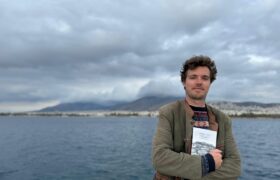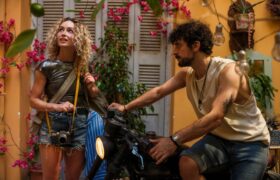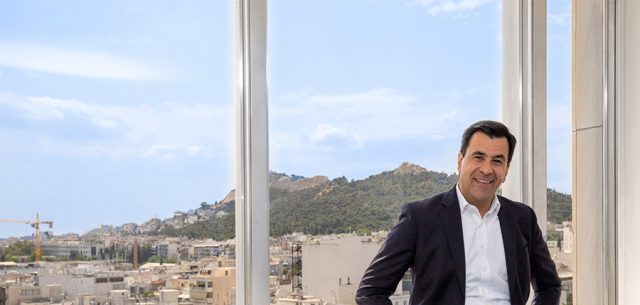A Magical Tour of Greece. Part 3: Mountains
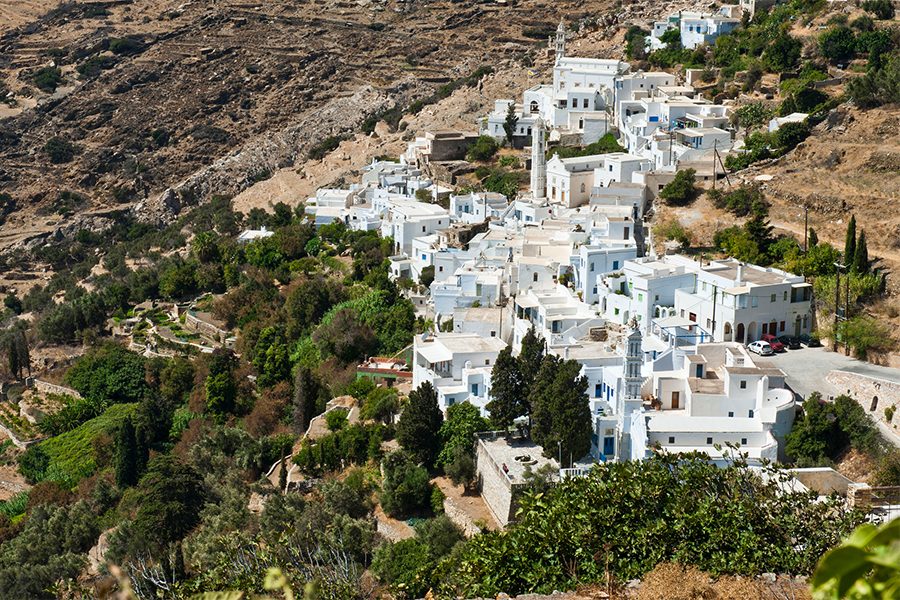
Tinos ©Y.Skoulas
In the third and final leg of his Magical Tour, John Kittmer takes us atop mountains he has yet to conquer, across inhospitable cliffs that plunge into turbid, inky waters.
In my gloomier and lonelier moments in the ambassador’s office in the ugly concrete block of the Athens Embassy, I would part the bomb curtains at the windows and look wistfully at Mt Hymettos, recalling the Psalmist’s words: ‘I will lift up mine eyes unto the hills from whence cometh my help’. It was always a comfort, of sorts. Since my very first visit to Greece, I have associated the Greek mountains with the real spirit of the country. So it is inevitable that this —the third and final stage of my imaginary (and compensatory) tour of Greece— should see me on mountain paths, a stick in each hand and a well-provisioned rucksack and tent on my back.
I am not a ‘natural’ mountain-walker. I suffer from vertigo, which can sometimes become acute. When the fear overtakes me, I have to shuffle —on all fours or on my backside— across saddles and ledges and rocks which may pose no problem at all to the luckier hiker. It’s not dignified. But I love mountains. I love the exhilaration and hard graft of the ascent, the odd expectation of the unexpected, the contact with nature, the satisfaction of the commanding view from the peak, the gentle descent back to plains and valleys. I was introduced to the Greek mountains by my classics teacher, Gerald Thompson, in 1984. Gerald had climbed every significant peak on the mainland and on the Aegean islands. His walking guide to Aegina can still be bought on that island, and his wonderful guide to walking on 42 Aegean islands (which was finished in 1987 but never published) is available on-line here. Gerald believed that you only encounter the real Greece if you take to your feet, absorbing the landscape at a human pace and investing your own toil and sweat in it. I’ve never seen fit to disagree.
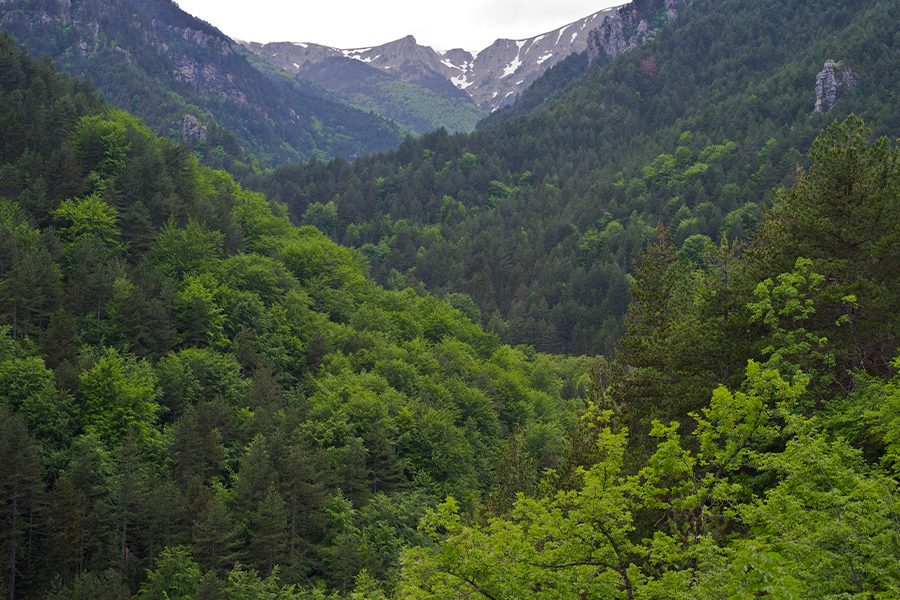
Mt. Olympos ©Kakarouhas
Over the years, I’ve walked a lot (though never enough) in Greece: Olympos, Taygetos, Athos, Tymphe, Parnassos; the Vikos Gorge, the Samaria Gorge; across and around several smaller islands. As in parts one and two of this magical six-day journey, I want to turn now to peaks I’ve not climbed. These four journeys are my four priorities for when Covid-19 goes and we are once again free to roam physically over the unsurpassable landscapes of Hellas. On this journey, I’m taking with me the indispensable Cicerone guides: The Mountains of Greece by Tim Salmon and Michael Cullen, and The High Mountains of Crete by Loraine Wilson, together with the relevant 1:50,000 maps by Anavasi, a compass, a whistle and a pocket torch. Put your boots on and join me.
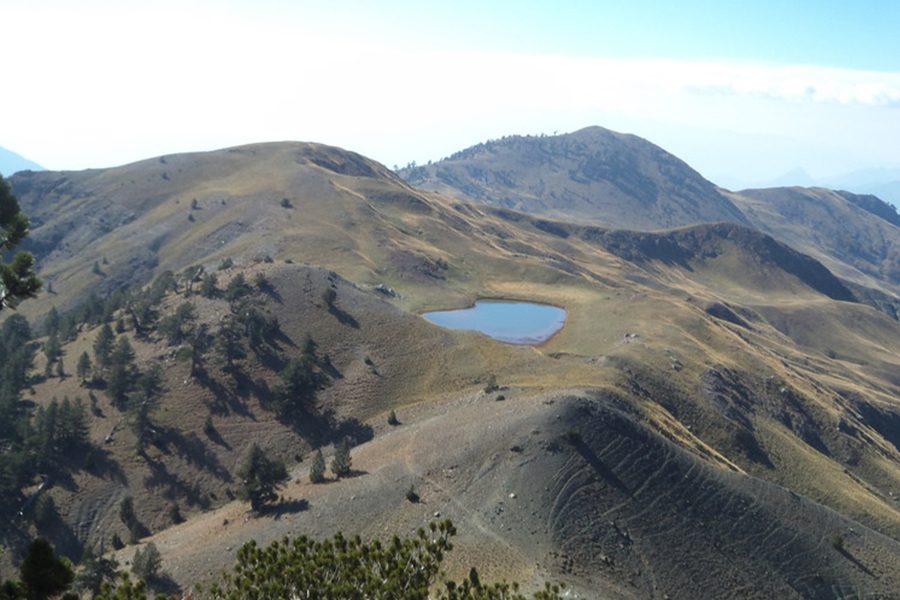
Mt Smolikas, Macedonia
I first saw Mt Smolikas on a circular walk of the Vikos Gorge and Mt Tymphe in 2016. We had left our bags at the refuge on the saddle near Astrakas and were walking towards the Drakolimni, the ‘Dragon’s Lake’. (You can find an account of some of that walk here). As we climbed higher, it became clear that the lake above us was on a plateau bounded by rock and ravine. Mt Gamila towered to our right. Through the ravine (a vertiginous fissure in the rock), even higher mountains arose to the east of us, daunting in their scale and majestic in their appearance. Another spur of the Pindus Mountains! As I worked out in my head the map of what we were seeing, I realised that the main peak must be Smolikas. It immediately moved towards the top of my list of challenges and I planned to do it with friends last September, but was prevented by health problems.
At 2,637m (8,650ft) Smolikas is the second-highest mountain in Greece, after Olympos. It is craggy at the peak, but otherwise lushly forested (black pine, beech, Balkan pine) or covered in grasses. Patrick Leigh Fermor has left us a powerful description of hiking in this area in the summer of 1972, in his correspondence with Deborah Devonshire, In Tearing Haste. But the most enchanting account is by Tim Salmon, in Part II of The Unwritten Places. This describes how Salmon came to join the Vlakh shepherds in their annual transhumance of flocks from the village of Samarina, on the high slopes of Smolikas, down to winter pasturage in Thessaly. An amazing account. I shall not attempt anything so dramatic. A drive to Palioseli, followed by two or three days on the mountain, with one or two nights in the refuge. Wonderful.
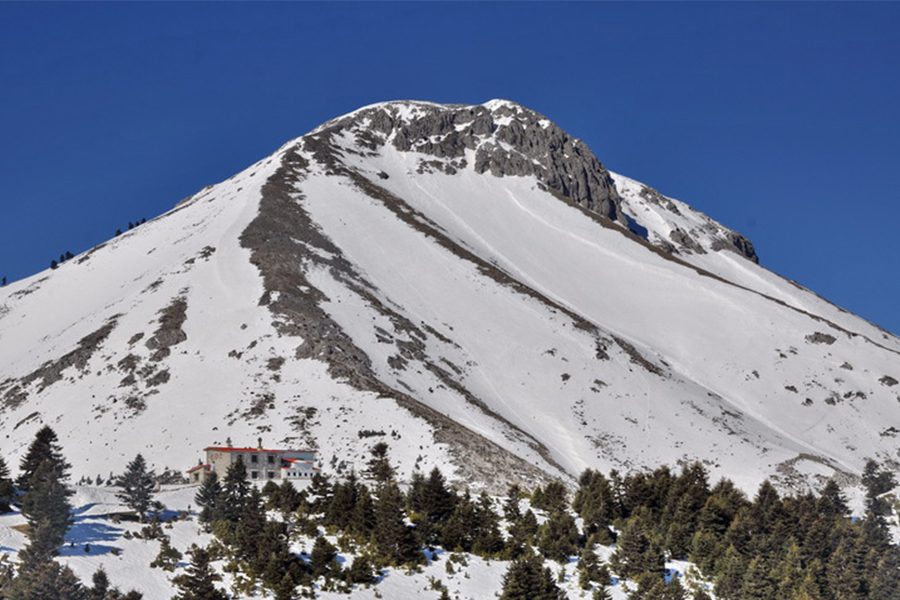
Mt Dirfys, Evia ©Mountain Weather Forecast
At 1,743m (5,725ft) Mt Dirfys is outside the top 50 peaks of Greece. But it’s on my list for sentimental reasons. First, I love Evia (Euboea) – particularly in its richly forested north-western half – and have spent many happy holidays here. The roads on this island are among the most dramatic and beautiful in Greece, whether cantilevered at the coastal edge or cutting through the central spine of forested mountains. Dirfys, Evia’s highest peak, dominates the island’s south-eastern reaches, its conical shape instantly recognisable. This was also one of Gerald’s favourite walks and he would describe with great animation how on his treks there in high summer he had often been lifted clear of the ground by the astonishing funnelling of the meltemi wind through the ravine. A little danger always adds spice to a walk. Gerald advised taking accommodation at the village of Steni Dirfyos, which is ‘squeezed between the two mighty jaws of the ravine’, and setting a day aside for the walk to the peak – called Delphi – and back. As on the greatest walks in Greece, the combination of forest, seascape and barren crags is evidently majestic. Of the ‘astonishing view’ at the peak Gerald says this:
[it] justifies and rewards all the hazards and efforts involved in the ascent. The whole island lies submissive at one’s feet. […]. To the west, the boundless dark forest sweeps down to the fertile plain and the tranquil waters of the Euripus, across which you may identify the mountains of Attica, and if the visibility is good, the huge bulk of Parnassos beyond. On the inhospitable east coast, the cliffs plunge sheer into the turbid inky waters of the Aegean, while southwards, enfolded in clouds, range upon range rolls down to Carystos, even then to continue in a regular chain via Andros and Tinos into the Cyclades.
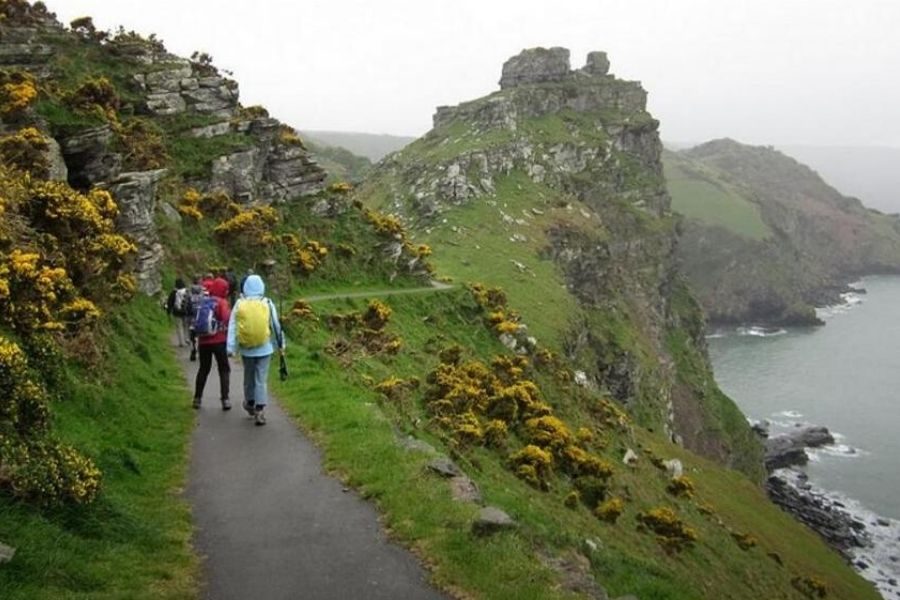 To witness the sublime in exchange for a day’s labour sounds a good bargain to me.
To witness the sublime in exchange for a day’s labour sounds a good bargain to me.
I don’t think you can be a British lover of Greece and not want to walk the mountains of Crete: whether the White Mountains in the west (2,453m / 8,050ft), the central peak of Psiloreitis – anciently called Ida, where Zeus was born (2,456 m / 8,058 ft), or the eastern heights of Mount Dikti (2,148m / 7,047ft). Crete – the Great Island – is incomparably beautiful and is incomparably rich in archaeology, history and fable. But its magnificent mountains acquired a new layer of narrative during the Second World War, as the centre of resistance activities by allied servicemen and Cretan fighters.

The hide-and-seek wireless activities of the Special Operations Executive (SOE), the famous Cretan runners, the clandestine movements of servicemen on and off the island, the kidnap of General Kreipe – all of this modern derring-do has added significantly to the island’s ancient mythology and has incidentally enhanced the appeal and stature of walking in these great mountains: mountains which always seem, whether by land or by sea, to be of continental scale. The indispensable book is, of course, George Psychoundakis’ The Cretan Runner, in Patrick Leigh Fermor’s translation. But W. Stanley Moss’s Ill Met By Moonlight and Leigh Fermor’s own Abducting a General are also must-reads.
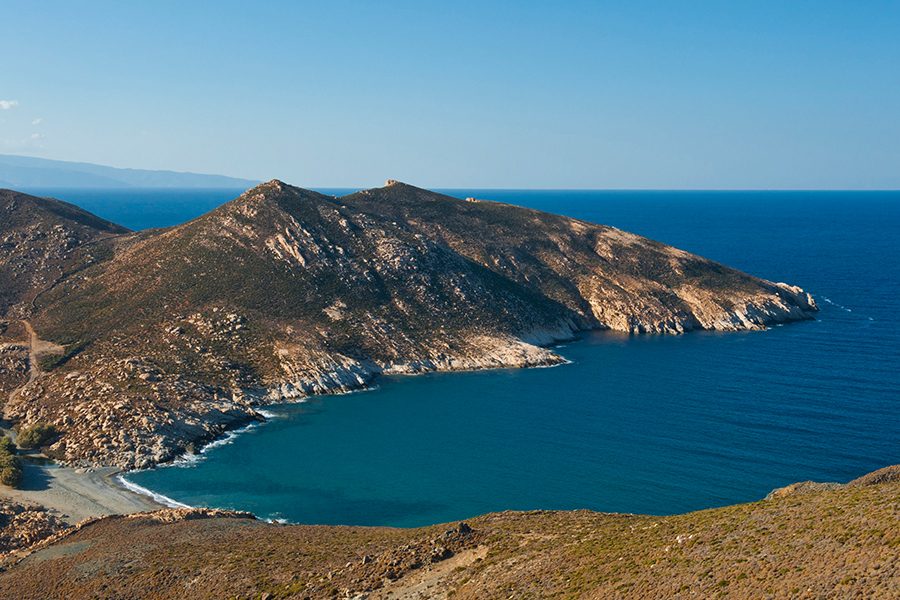
Tinos ©Y.Skoulas
After the war, many of the servicemen who served on Crete came back to walk the mountains; and many who hadn’t served there were inspired to follow in their footsteps. Two of the best accounts of Resistance-inspired hikes are by Xan Fielding and Dilys Powell. In 1959, Powell was on Crete, staying with the British School at Athens in Knossos, when she decided she wanted to trace – in reverse direction – part of the route taken by Kreipe and his kidnappers. Her gruelling journey by foot over Mt Ida, from Nithavris to Anoyeia, is brilliantly recorded in chapter VI of The Villa Ariadne.
But in this magical walk, I want to concentrate on the White Mountains. I guess that everyone who loves Crete has their favourite part of the island. For me, the Great Island is at its best in the west. The White Mountains are majestic: here they form the island’s spine, opening up incredible ravines and gorges to north and south, and meeting the sea on the west coast in the most spectacular fashion. Here the heave and movement of the land are evident in the displacement of ancient harbours, the twisting and turning of rock formations. I think the best guide to the White Mountains is The Stronghold: Four Seasons in the White Mountains of Crete by Xan Fielding. From January 1942 to January 1944, Fielding was an SOE officer on Crete. After the war, he returned and spent a year (1951-2) in the White Mountains, living alongside its inhabitants and becoming even more intimately acquainted with the terrain. I have myself walked already in this roughly semicircular area (which he called the ‘stronghold’ because of its defensive capacity) – along the extraordinary Samaria Gorge. But I haven’t done the high peaks. With Fielding as my inspiration and Cicerone as my practical guide, I shall do so now. If I’m lucky, I shall get to see – in these six magical days – something of all four seasons in this amazing landscape. I shall make sure to have in my hip flask a saving draught of tsikhoudia.

My final climb takes me to the Peloponnese. In 2015, I undertook a long walk in the southern Peloponnese, partly to tread sections of the route walked by Paddy and Joan Leigh Fermor and recorded in chapter 1 of Mani, and partly to conquer Taygetos (2,404m / 7,887ft). On that occasion, I vanquished my vertigo and got to the top. But the most memorable part of the walk was when we emerged unexpectedly out of a dense, cool beech forest to find ourselves in paradise: an alpine meadow ablaze with colour (wild plants of every description in bloom), sweet from the rivulets of freshwater flowing out of the mountainside and alive with the buzzing of bees and insects and the flapping of butterfly wings. (My blog of the time has more about this walk here.)
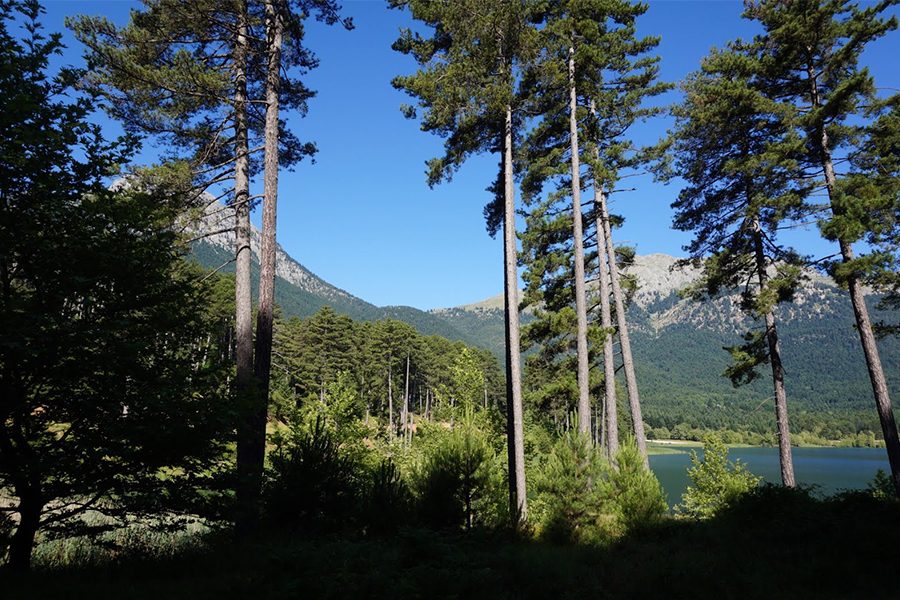
Mt Chelmos from Lake Doxa
On this occasion, however, I want to walk in the north of the peninsula, to tackle the second and third highest peaks of the Peloponnese. In Corinthia, bounding the sea to the north and Arcadia to the south, there is a mighty ring of mountains, which trap a series of high water basins and plateaux. I have stayed in this area several times, at a lovely village called Goura, high above the Feneos plain. That plateau is now arable land, but it was once a huge lake, connected underground to the famous Stymphalian Lake, which still exists. The plain of Feneos is trapped between Mt Chelmos (anciently Aroania) and Mt Zirea (anciently Cyllene), both of which are good for walking. I’ve been some of the way up Zirea by jeep: to a beautiful mountain plain, where wild horses were running free. But the peak (2,376m / 7,794ft) has escaped me. It needs to be tackled. The other side of the plain is bounded by Mt Chelmos (2,355m / 7,726ft). This mountain presents an almost sheer face to Feneos (spectacularly so at the beautiful Lake Doxa) and needs to be approached from the other side – from the pretty mountain resort of Kalavryta, where history famously records that the banner of defiance was first raised at the Monastery of the Holy Lavra, at the start of the Greek War of Independence, 25 March 1821.
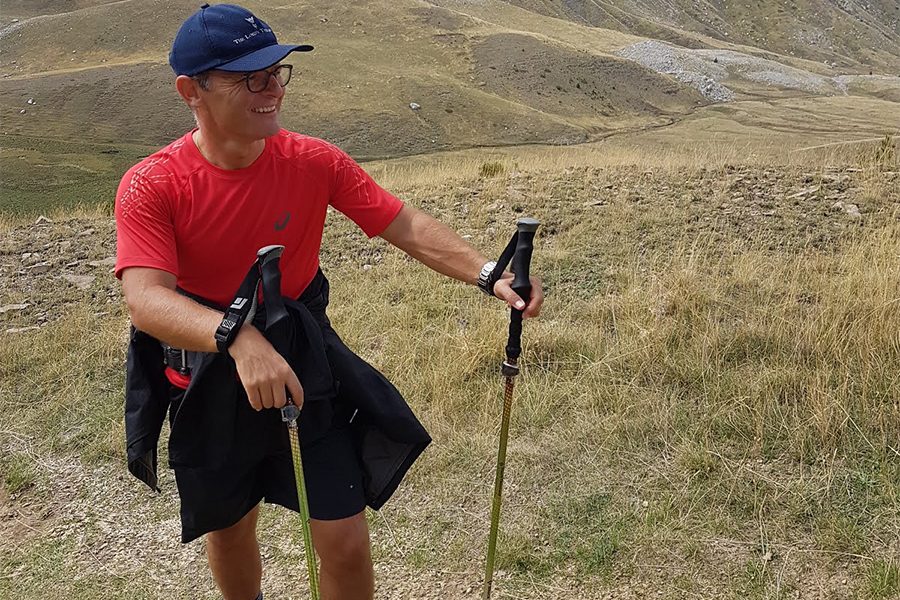
The author hiking on Mt Gamila near Astrakas
Walking is often an enjoyable solitary pleasure. But actually, I prefer to walk with friends – especially if we’re all more or less equally fit, more or less equally determined. Since I am a know-nothing classicist and literary geek, I am always glad to have friends walking with me who are botanists or zoologists, who can tell me what things are, how nature fits together. Human memory is weak and fallible if we can’t name things. So when the weather is perfect and the walking is good underfoot and my fellow hikers tell me the names of plants and insects and birds in Greek, then I am in the highest heaven. Then the unity of the Greek language and Greek nature is sealed, and the doxology is being sung.
************************************
In these three parts of my blog, I have taken you on a magical, complex, impossible six-day journey, to fill the time I would have spent in Greece at the end of June. My flight and my trip have now been definitively cancelled. For me, the Greek summer will certainly have to be a state of mind. But I hope you will agree with me that to imagine the Greek summer deeply – by land, by sea and on mountain peaks – is not a bad substitute for being there. Thank you for sharing this journey with me.
John Kittmer is an independent researcher, who is working on the poetry of Yannis Ritsos. This article first appeared in the author’s blog

